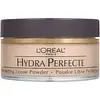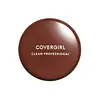What's inside
What's inside
 Key Ingredients
Key Ingredients

No key ingredients
 Benefits
Benefits

No benefits
 Concerns
Concerns

 Ingredients Side-by-side
Ingredients Side-by-side

Nylon-12
Ptfe
Acrylates Copolymer
Trioctyldodecyl Citrate
EmollientMagnesium Stearate
Cosmetic ColorantBoron Nitride
AbsorbentParaffinum Liquidum
EmollientLauroyl Lysine
Skin ConditioningIsopropyl Titanium Triisostearate
EmollientParfum
MaskingBenzyl Salicylate
PerfumingHydroxyisohexyl 3-Cyclohexene Carboxaldehyde
MaskingAlpha-Isomethyl Ionone
PerfumingHydroxycitronellal
PerfumingGeraniol
PerfumingCoumarin
PerfumingHexyl Cinnamal
PerfumingLinalool
PerfumingIsoeugenol
PerfumingEugenol
PerfumingCinnamyl Alcohol
PerfumingCitronellol
PerfumingMica
Cosmetic ColorantCI 77499
Cosmetic ColorantCI 77491
Cosmetic ColorantCI 77492
Cosmetic ColorantCI 77120
Cosmetic ColorantCI 77891
Cosmetic ColorantNylon-12, Ptfe, Acrylates Copolymer, Trioctyldodecyl Citrate, Magnesium Stearate, Boron Nitride, Paraffinum Liquidum, Lauroyl Lysine, Isopropyl Titanium Triisostearate, Parfum, Benzyl Salicylate, Hydroxyisohexyl 3-Cyclohexene Carboxaldehyde, Alpha-Isomethyl Ionone, Hydroxycitronellal, Geraniol, Coumarin, Hexyl Cinnamal, Linalool, Isoeugenol, Eugenol, Cinnamyl Alcohol, Citronellol, Mica, CI 77499, CI 77491, CI 77492, CI 77120, CI 77891
Talc
AbrasiveAvena Sativa Kernel Flour
AbrasiveCalcium Silicate
AbsorbentZinc Stearate
Cosmetic ColorantParfum
MaskingDimethicone
EmollientEucalyptus Globulus Leaf Oil
PerfumingSodium Dehydroacetate
PreservativeCamphor
MaskingParaffinum Liquidum
EmollientMenthol
MaskingIsopropyl Myristate
EmollientPropylparaben
PreservativeEugenia Caryophyllus Flower Oil
MaskingMethylparaben
PreservativeQuaternium-15
PreservativeBHT
AntioxidantMica
Cosmetic ColorantIron Oxides
Talc, Avena Sativa Kernel Flour, Calcium Silicate, Zinc Stearate, Parfum, Dimethicone, Eucalyptus Globulus Leaf Oil, Sodium Dehydroacetate, Camphor, Paraffinum Liquidum, Menthol, Isopropyl Myristate, Propylparaben, Eugenia Caryophyllus Flower Oil, Methylparaben, Quaternium-15, BHT, Mica, Iron Oxides
 Reviews
Reviews

Ingredients Explained
These ingredients are found in both products.
Ingredients higher up in an ingredient list are typically present in a larger amount.
Mica is a naturally occurring mineral used to add shimmer and color in cosmetics. It can also help improve the texture of a product or give it an opaque, white/silver color.
Serecite is the name for very fine but ragged grains of mica.
This ingredient is often coated with metal oxides like titanium dioxide. Trace amounts of heavy metals may be found in mica, but these metals are not harmful in our personal products.
Mica has been used since prehistoric times throughout the world. Ancient Egyptian, Indian, Greek, Roman, Aztec, and Chinese civilizations have used mica.
Learn more about MicaParaffinum Liquidum is also known as liquid paraffin. It is a type of highly refined mineral oil.
Like other oils, Paraffinum Liquidum has emollient properties. Emollients help soothe and soften the skin. By creating a barrier to trap moisture within, emollients help keep your skin hydrated.
Paraffinum Liquidum does not irritate the skin and is non-comedogenic.
Learn more about Paraffinum LiquidumParfum is a catch-all term for an ingredient or more that is used to give a scent to products.
Also called "fragrance", this ingredient can be a blend of hundreds of chemicals or plant oils. This means every product with "fragrance" or "parfum" in the ingredients list is a different mixture.
For instance, Habanolide is a proprietary trade name for a specific aroma chemical. When used as a fragrance ingredient in cosmetics, most aroma chemicals fall under the broad labeling category of “FRAGRANCE” or “PARFUM” according to EU and US regulations.
The term 'parfum' or 'fragrance' is not regulated in many countries. In many cases, it is up to the brand to define this term.
For instance, many brands choose to label themselves as "fragrance-free" because they are not using synthetic fragrances. However, their products may still contain ingredients such as essential oils that are considered a fragrance by INCI standards.
One example is Calendula flower extract. Calendula is an essential oil that still imparts a scent or 'fragrance'.
Depending on the blend, the ingredients in the mixture can cause allergies and sensitivities on the skin. Some ingredients that are known EU allergens include linalool and citronellol.
Parfum can also be used to mask or cover an unpleasant scent.
The bottom line is: not all fragrances/parfum/ingredients are created equally. If you are worried about fragrances, we recommend taking a closer look at an ingredient. And of course, we always recommend speaking with a professional.
Learn more about Parfum